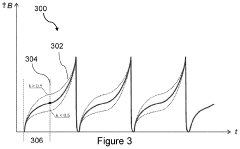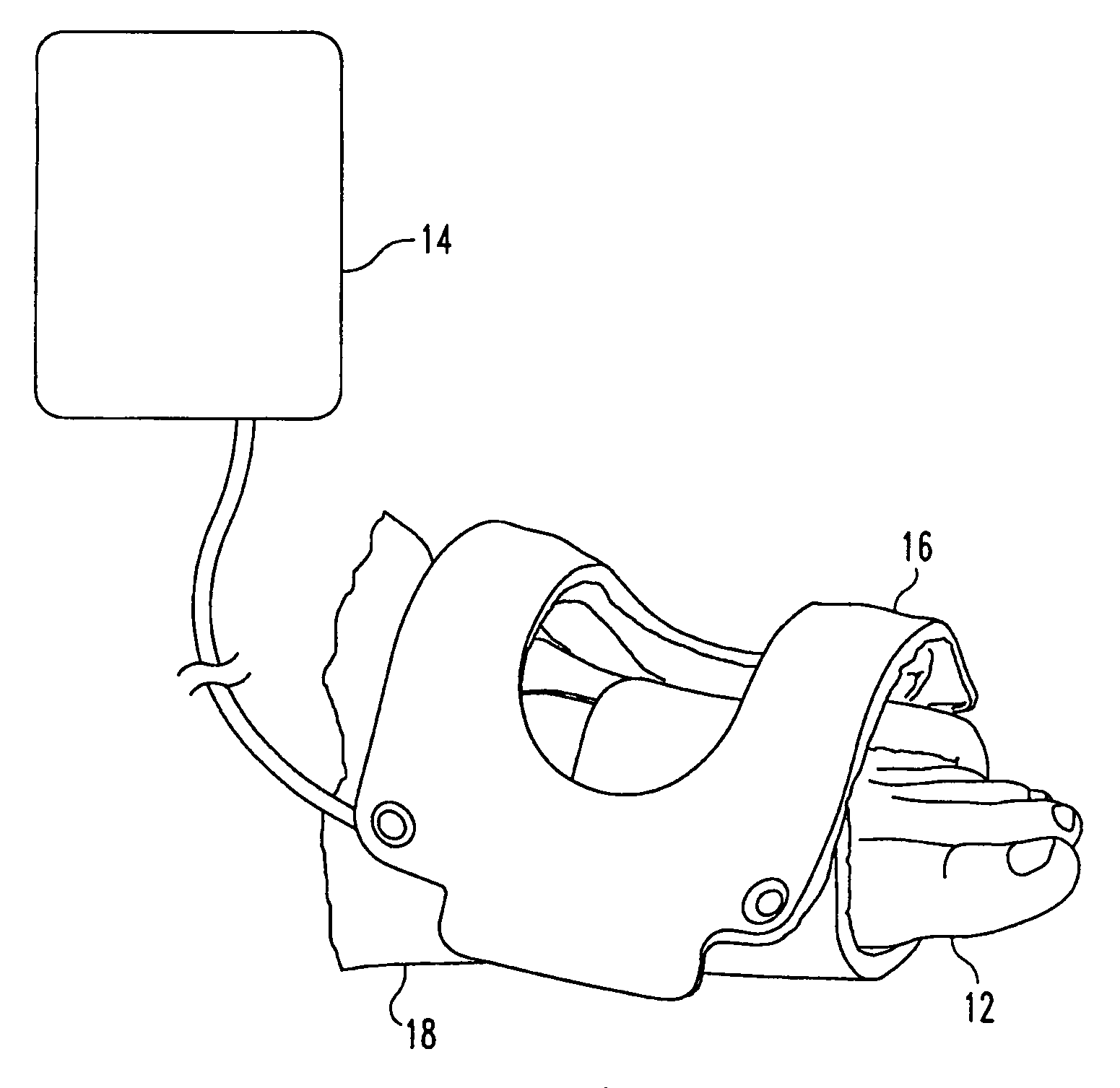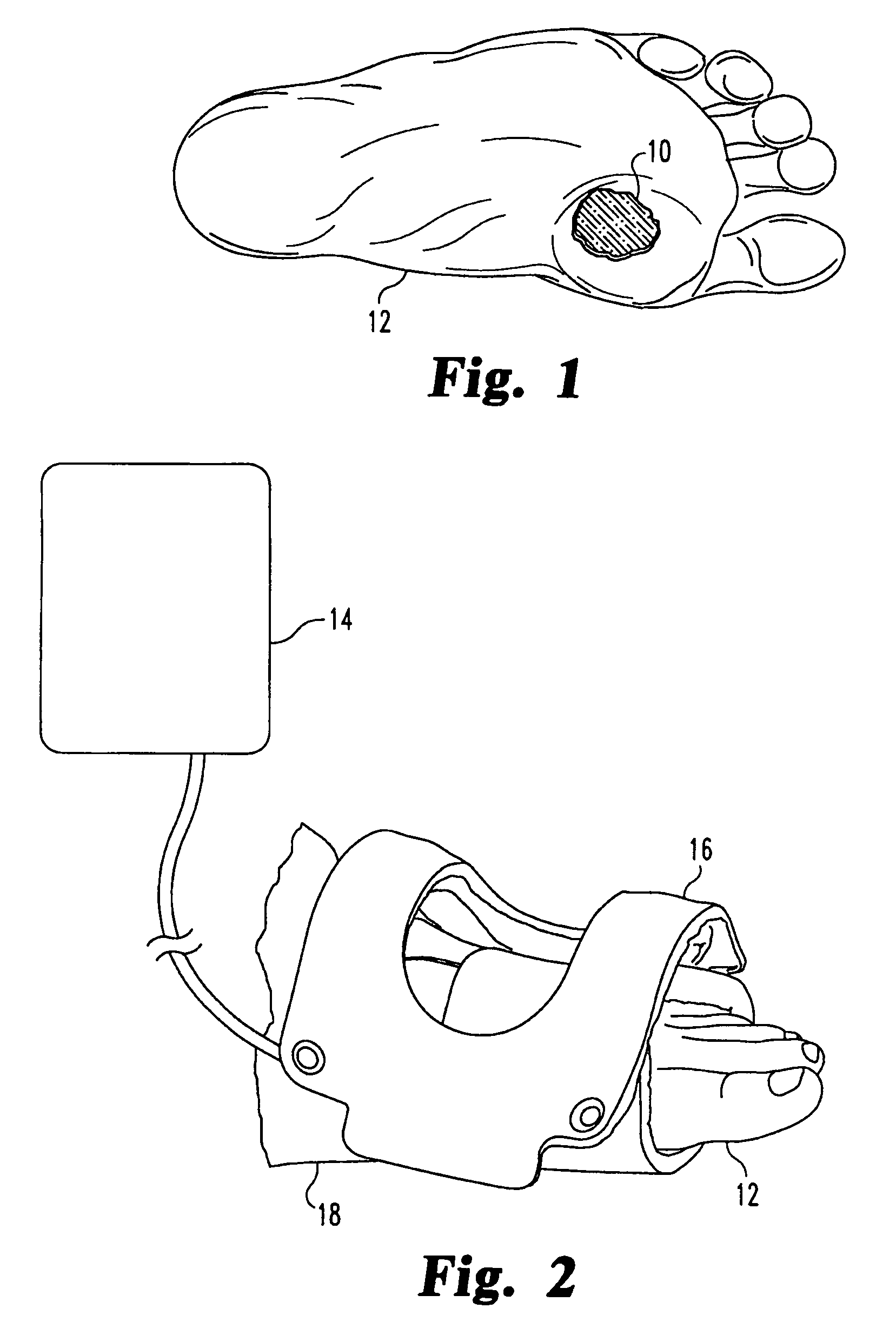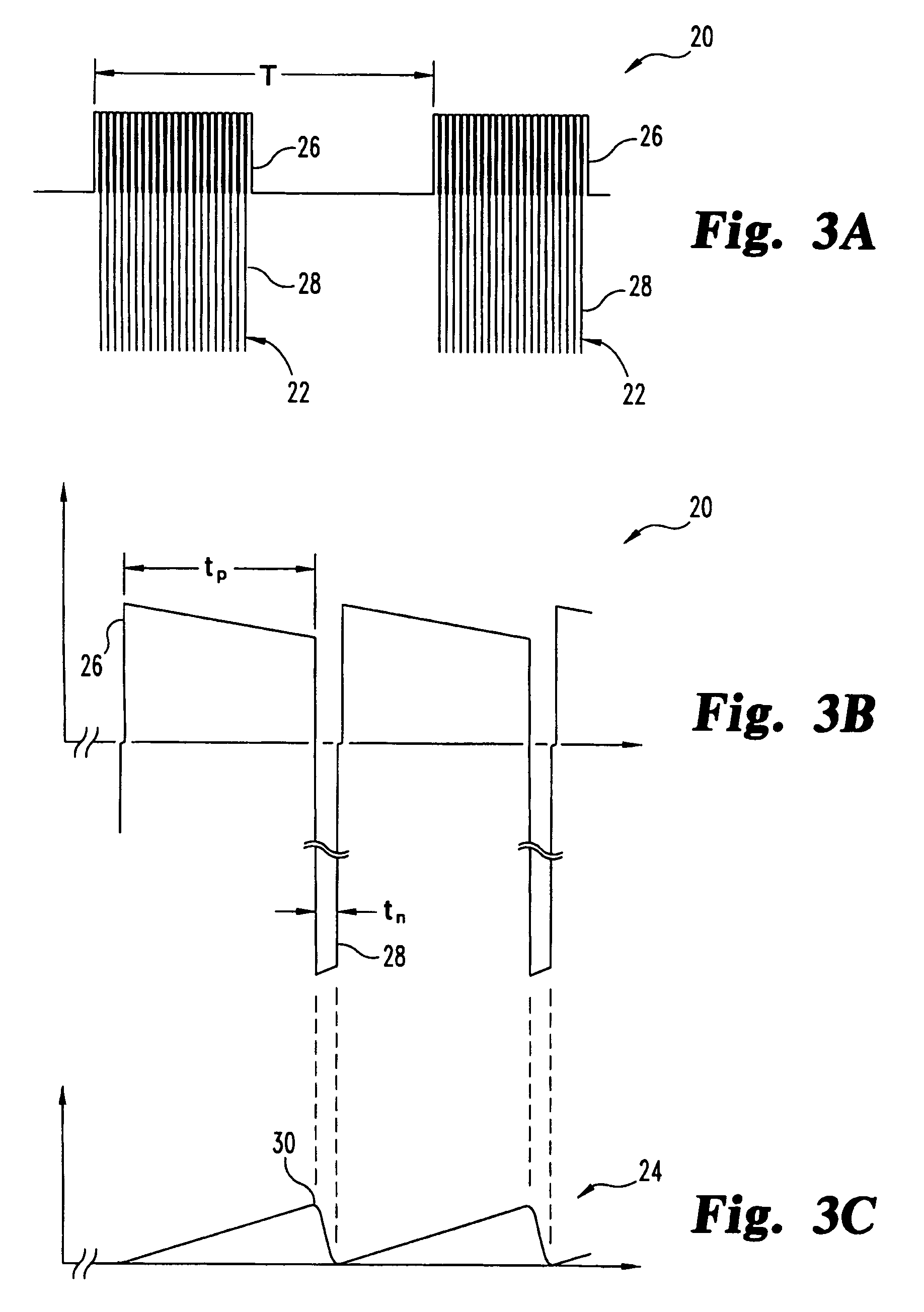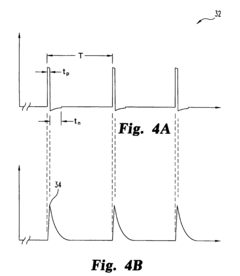Comparing Different Frequency Waves in PEMF Therapy Applications
AUG 11, 20259 MIN READ
Generate Your Research Report Instantly with AI Agent
Patsnap Eureka helps you evaluate technical feasibility & market potential.
PEMF Therapy Background
Pulsed Electromagnetic Field (PEMF) therapy has emerged as a promising non-invasive treatment modality in recent decades. This therapeutic approach harnesses the power of electromagnetic fields to stimulate cellular repair and promote overall health. The concept of using electromagnetic fields for healing can be traced back to the mid-20th century, with significant advancements occurring in the 1970s and 1980s.
PEMF therapy operates on the principle that electromagnetic fields can influence biological processes at the cellular level. By applying pulsed electromagnetic fields to the body, this therapy aims to enhance cellular function, improve circulation, reduce inflammation, and accelerate healing processes. The underlying mechanism involves the interaction between the applied electromagnetic fields and the body's own electromagnetic fields, which are generated by various physiological processes.
The development of PEMF therapy has been driven by a growing understanding of bioelectromagnetics and the recognition that electromagnetic fields play a crucial role in cellular communication and regulation. Research has shown that different tissues and cells respond to specific frequencies and intensities of electromagnetic fields, leading to the exploration of various frequency ranges in PEMF applications.
Initially, PEMF therapy gained recognition for its effectiveness in promoting bone healing, particularly in cases of non-union fractures. This led to its FDA approval for the treatment of certain bone disorders in the 1970s. Since then, the scope of PEMF therapy has expanded significantly, with applications ranging from pain management and wound healing to neurological disorders and sports medicine.
The evolution of PEMF technology has seen the development of diverse devices and treatment protocols. These range from large, stationary units used in clinical settings to portable, home-use devices. The variety in PEMF devices reflects the ongoing research into optimal frequency ranges, waveforms, and treatment durations for different health conditions.
As the field of PEMF therapy has grown, so has the interest in comparing the efficacy of different frequency waves. This comparative approach aims to identify the most effective frequencies for specific health conditions and to optimize treatment protocols. The exploration of frequency-dependent effects has become a key area of research, with studies investigating low-frequency, mid-frequency, and high-frequency PEMF applications.
The background of PEMF therapy sets the stage for a deeper examination of how different frequency waves compare in their therapeutic applications. This comparison is crucial for advancing the field, as it helps in tailoring treatments to specific conditions and understanding the underlying mechanisms of PEMF's biological effects.
PEMF therapy operates on the principle that electromagnetic fields can influence biological processes at the cellular level. By applying pulsed electromagnetic fields to the body, this therapy aims to enhance cellular function, improve circulation, reduce inflammation, and accelerate healing processes. The underlying mechanism involves the interaction between the applied electromagnetic fields and the body's own electromagnetic fields, which are generated by various physiological processes.
The development of PEMF therapy has been driven by a growing understanding of bioelectromagnetics and the recognition that electromagnetic fields play a crucial role in cellular communication and regulation. Research has shown that different tissues and cells respond to specific frequencies and intensities of electromagnetic fields, leading to the exploration of various frequency ranges in PEMF applications.
Initially, PEMF therapy gained recognition for its effectiveness in promoting bone healing, particularly in cases of non-union fractures. This led to its FDA approval for the treatment of certain bone disorders in the 1970s. Since then, the scope of PEMF therapy has expanded significantly, with applications ranging from pain management and wound healing to neurological disorders and sports medicine.
The evolution of PEMF technology has seen the development of diverse devices and treatment protocols. These range from large, stationary units used in clinical settings to portable, home-use devices. The variety in PEMF devices reflects the ongoing research into optimal frequency ranges, waveforms, and treatment durations for different health conditions.
As the field of PEMF therapy has grown, so has the interest in comparing the efficacy of different frequency waves. This comparative approach aims to identify the most effective frequencies for specific health conditions and to optimize treatment protocols. The exploration of frequency-dependent effects has become a key area of research, with studies investigating low-frequency, mid-frequency, and high-frequency PEMF applications.
The background of PEMF therapy sets the stage for a deeper examination of how different frequency waves compare in their therapeutic applications. This comparison is crucial for advancing the field, as it helps in tailoring treatments to specific conditions and understanding the underlying mechanisms of PEMF's biological effects.
Market Analysis PEMF
The PEMF (Pulsed Electromagnetic Field) therapy market has shown significant growth in recent years, driven by increasing awareness of its potential health benefits and expanding applications in various medical fields. The global PEMF therapy devices market was valued at approximately $500 million in 2020 and is projected to reach over $1 billion by 2027, with a compound annual growth rate (CAGR) of around 12% during the forecast period.
The market for PEMF therapy devices is segmented based on application, end-user, and geography. Major applications include pain management, bone healing, neurological disorders, and wound healing. Pain management remains the largest segment, accounting for over 40% of the market share, due to the rising prevalence of chronic pain conditions and the growing demand for non-invasive treatment options.
Geographically, North America dominates the PEMF therapy market, followed by Europe and Asia-Pacific. The United States holds the largest market share, driven by a high prevalence of chronic diseases, well-established healthcare infrastructure, and increasing adoption of alternative therapies. However, the Asia-Pacific region is expected to witness the fastest growth, attributed to rising healthcare expenditure, growing awareness of PEMF therapy, and improving access to advanced medical technologies.
Key market drivers include the increasing prevalence of chronic diseases, growing geriatric population, and rising demand for non-invasive pain management solutions. Additionally, ongoing research and development activities exploring new applications of PEMF therapy in areas such as mental health and sports medicine are expected to create new growth opportunities.
However, the market faces challenges such as the lack of standardized protocols for PEMF therapy, limited reimbursement policies, and skepticism among some healthcare professionals regarding its efficacy. These factors may hinder market growth to some extent.
The competitive landscape of the PEMF therapy market is characterized by the presence of several established players and numerous small to medium-sized companies. Key market players are focusing on product innovation, expanding their product portfolios, and strategic collaborations to gain a competitive edge. The market is also witnessing the entry of new players, particularly in emerging economies, which is intensifying competition and driving innovation in PEMF device technology.
The market for PEMF therapy devices is segmented based on application, end-user, and geography. Major applications include pain management, bone healing, neurological disorders, and wound healing. Pain management remains the largest segment, accounting for over 40% of the market share, due to the rising prevalence of chronic pain conditions and the growing demand for non-invasive treatment options.
Geographically, North America dominates the PEMF therapy market, followed by Europe and Asia-Pacific. The United States holds the largest market share, driven by a high prevalence of chronic diseases, well-established healthcare infrastructure, and increasing adoption of alternative therapies. However, the Asia-Pacific region is expected to witness the fastest growth, attributed to rising healthcare expenditure, growing awareness of PEMF therapy, and improving access to advanced medical technologies.
Key market drivers include the increasing prevalence of chronic diseases, growing geriatric population, and rising demand for non-invasive pain management solutions. Additionally, ongoing research and development activities exploring new applications of PEMF therapy in areas such as mental health and sports medicine are expected to create new growth opportunities.
However, the market faces challenges such as the lack of standardized protocols for PEMF therapy, limited reimbursement policies, and skepticism among some healthcare professionals regarding its efficacy. These factors may hinder market growth to some extent.
The competitive landscape of the PEMF therapy market is characterized by the presence of several established players and numerous small to medium-sized companies. Key market players are focusing on product innovation, expanding their product portfolios, and strategic collaborations to gain a competitive edge. The market is also witnessing the entry of new players, particularly in emerging economies, which is intensifying competition and driving innovation in PEMF device technology.
PEMF Tech Challenges
Pulsed Electromagnetic Field (PEMF) therapy has shown promising results in various medical applications, but it faces several technical challenges that need to be addressed for wider adoption and improved efficacy. One of the primary challenges is the optimization of frequency waves for specific therapeutic purposes. Different frequencies have varying effects on biological tissues, and determining the most effective frequency for each application requires extensive research and clinical trials.
Another significant challenge is the development of precise and controllable PEMF devices. The ability to generate consistent and accurate electromagnetic fields with specific frequencies, intensities, and waveforms is crucial for achieving reproducible therapeutic outcomes. This requires advanced engineering in both hardware and software components of PEMF devices.
The penetration depth of electromagnetic fields is also a critical factor in PEMF therapy. Higher frequencies tend to have shallower penetration, while lower frequencies can reach deeper tissues. Balancing the desired therapeutic effect with the required penetration depth poses a challenge in device design and treatment protocols.
Dosimetry and treatment standardization present additional hurdles. Establishing standardized protocols for different medical conditions, including optimal treatment duration, frequency, and intensity, is essential for consistent results across patients and healthcare providers. This standardization is complicated by individual variations in patient physiology and the diverse range of conditions treated with PEMF therapy.
The interaction between PEMF and other medical treatments or devices is another area of concern. Ensuring compatibility and safety when used in conjunction with other therapies or in patients with implanted medical devices requires thorough investigation and careful consideration in clinical settings.
Miniaturization and portability of PEMF devices present both opportunities and challenges. While smaller, more portable devices can improve patient compliance and enable home-based treatments, maintaining the necessary power and field strength in compact designs is technically demanding.
Long-term effects and safety considerations of PEMF therapy, especially with prolonged use, need further study. While short-term safety has been established in many applications, the potential cumulative effects of long-term exposure to pulsed electromagnetic fields require ongoing research and monitoring.
Lastly, the development of personalized PEMF treatments tailored to individual patient needs and responses is an emerging challenge. This involves integrating real-time biofeedback mechanisms and adaptive algorithms into PEMF devices to optimize treatment parameters dynamically based on patient response.
Another significant challenge is the development of precise and controllable PEMF devices. The ability to generate consistent and accurate electromagnetic fields with specific frequencies, intensities, and waveforms is crucial for achieving reproducible therapeutic outcomes. This requires advanced engineering in both hardware and software components of PEMF devices.
The penetration depth of electromagnetic fields is also a critical factor in PEMF therapy. Higher frequencies tend to have shallower penetration, while lower frequencies can reach deeper tissues. Balancing the desired therapeutic effect with the required penetration depth poses a challenge in device design and treatment protocols.
Dosimetry and treatment standardization present additional hurdles. Establishing standardized protocols for different medical conditions, including optimal treatment duration, frequency, and intensity, is essential for consistent results across patients and healthcare providers. This standardization is complicated by individual variations in patient physiology and the diverse range of conditions treated with PEMF therapy.
The interaction between PEMF and other medical treatments or devices is another area of concern. Ensuring compatibility and safety when used in conjunction with other therapies or in patients with implanted medical devices requires thorough investigation and careful consideration in clinical settings.
Miniaturization and portability of PEMF devices present both opportunities and challenges. While smaller, more portable devices can improve patient compliance and enable home-based treatments, maintaining the necessary power and field strength in compact designs is technically demanding.
Long-term effects and safety considerations of PEMF therapy, especially with prolonged use, need further study. While short-term safety has been established in many applications, the potential cumulative effects of long-term exposure to pulsed electromagnetic fields require ongoing research and monitoring.
Lastly, the development of personalized PEMF treatments tailored to individual patient needs and responses is an emerging challenge. This involves integrating real-time biofeedback mechanisms and adaptive algorithms into PEMF devices to optimize treatment parameters dynamically based on patient response.
Current PEMF Solutions
01 Frequency ranges for PEMF therapy
PEMF therapy utilizes various frequency ranges to target different therapeutic effects. Low-frequency ranges (typically 1-100 Hz) are often used for pain relief and tissue repair, while higher frequencies (up to several thousand Hz) may be employed for specific cellular effects. The choice of frequency depends on the intended therapeutic outcome and the condition being treated.- Frequency ranges for PEMF therapy: PEMF therapy utilizes various frequency ranges to target different therapeutic effects. Low-frequency ranges (typically 1-100 Hz) are often used for pain relief and tissue repair, while higher frequencies (up to several thousand Hz) may be employed for specific cellular effects. The choice of frequency depends on the intended therapeutic outcome and the condition being treated.
- Waveform characteristics in PEMF therapy: The waveform of the electromagnetic field plays a crucial role in PEMF therapy. Various waveforms such as sine waves, square waves, and sawtooth waves are used, each with potential specific therapeutic benefits. The shape, amplitude, and duration of these waveforms can be adjusted to optimize treatment efficacy for different conditions.
- Targeted application of PEMF therapy: PEMF therapy can be applied to specific body areas or used for whole-body treatment. Targeted application involves using specialized applicators or devices designed to focus the electromagnetic field on particular regions, such as joints or specific muscle groups. This approach allows for more concentrated therapy in areas of concern.
- Combination of PEMF with other therapies: PEMF therapy is often combined with other treatment modalities to enhance overall therapeutic effects. This may include integration with light therapy, heat therapy, or other forms of electromagnetic stimulation. The synergistic effects of these combinations can potentially improve treatment outcomes for various conditions.
- Customizable PEMF therapy protocols: Advanced PEMF devices offer customizable therapy protocols, allowing for adjustment of frequency, intensity, and duration based on individual patient needs. These programmable systems can store multiple treatment protocols and may include features for tracking treatment progress and adjusting parameters over time to optimize therapeutic outcomes.
02 Waveform shapes in PEMF therapy
Different waveform shapes are used in PEMF therapy, including sine waves, square waves, and sawtooth waves. Each waveform shape can have distinct biological effects and may be more suitable for specific therapeutic applications. The selection of waveform shape is often based on the desired penetration depth and the target tissue or cellular response.Expand Specific Solutions03 Pulse duration and intensity modulation
PEMF therapy devices often allow for adjustment of pulse duration and intensity. Shorter pulse durations with higher intensities may be used for deeper tissue penetration, while longer pulses at lower intensities might be preferred for superficial treatments. The ability to modulate these parameters enables customization of the therapy for individual patient needs and specific conditions.Expand Specific Solutions04 Combination with other therapies
PEMF therapy is often combined with other treatment modalities to enhance overall therapeutic effects. This may include integration with heat therapy, light therapy, or even pharmaceutical treatments. The synergistic effects of combined therapies can potentially improve treatment outcomes for various conditions, including pain management and tissue regeneration.Expand Specific Solutions05 Targeted application and device design
PEMF therapy devices are designed for targeted application to specific body areas or for whole-body treatment. This includes wearable devices, localized applicators, and full-body mats. The design of these devices takes into account the desired field strength, penetration depth, and the anatomical area being treated, allowing for more precise and effective therapy delivery.Expand Specific Solutions
PEMF Industry Players
The competitive landscape for Pulsed Electromagnetic Field (PEMF) therapy applications is in a growth phase, with increasing market size and technological advancements. The global PEMF therapy market is expanding rapidly, driven by growing awareness of non-invasive treatment options and increasing prevalence of chronic diseases. Companies like Venus Concept Ltd., Regenesis Biomedical, Inc., and SofPulse, Inc. are at the forefront of developing PEMF devices, focusing on different frequency ranges and applications. The technology's maturity varies across different frequency spectrums, with some companies like Galvanize Therapeutics, Inc. and Orthofix US LLC pushing boundaries in specific therapeutic areas. Research institutions such as the National University of Singapore and Swiss Federal Institute of Technology are contributing to the scientific understanding of PEMF effects, potentially influencing future innovations in the field.
Venus Concept Ltd.
Technical Solution: Venus Concept Ltd. has developed a proprietary PEMF technology that utilizes multi-polar magnetic fields with varying frequencies. Their approach combines low-frequency PEMF (1-50 Hz) with higher frequency components (up to 10 kHz) to create a complex waveform. This multi-frequency approach is designed to target different tissue types and cellular processes simultaneously. The company's PEMF devices use a patented VariPulse™ technology, which allows for dynamic adjustment of frequency and intensity during treatment sessions[1][3]. This adaptability enables personalized therapy protocols based on individual patient needs and specific conditions being treated.
Strengths: Versatile multi-frequency approach allows for targeting various therapeutic effects. Customizable treatments enhance patient-specific outcomes. Weaknesses: Complexity of the system may require more extensive training for operators.
Regenesis Biomedical, Inc.
Technical Solution: Regenesis Biomedical specializes in PEMF therapy with a focus on tissue regeneration and pain management. Their flagship device, the Provant Therapy System, utilizes a specific pulsed electromagnetic field frequency of 27.12 MHz[2]. This high-frequency approach is based on the principle that higher frequencies can penetrate deeper into tissues and potentially stimulate cellular processes more effectively. The company's technology is designed to promote angiogenesis, reduce inflammation, and accelerate wound healing. Regenesis has conducted several clinical studies demonstrating the efficacy of their high-frequency PEMF therapy in various applications, including post-operative pain reduction and chronic wound treatment[4][5].
Strengths: High-frequency approach may offer deeper tissue penetration. Focused applications in wound healing and pain management. Weaknesses: Limited frequency range may not be as versatile for other therapeutic applications.
Key PEMF Innovations
A pulsed electromagnetic field apparatus and method for generating frequencies
PatentWO2024127242A1
Innovation
- A PEMF apparatus with a pulse generator and electromagnetic field generation means that uses modified sawtooth waveforms with pre-stress and relaxation periods, and quasi-sine signals with pulse width modulation, along with a feedback circuit for frequency stability and precision, and a bifilar antenna for scalar wave generation.
Pulsed electromagnetic field method of treating soft tissue wounds
PatentActiveUS7520849B1
Innovation
- The use of a pulsed electromagnetic field (PEMF) with specific signal characteristics, including repetitive pulse bursts and unipolar magnetic field pulses, is applied externally to the wound area without direct contact, using a treatment coil and signal generator to promote wound healing.
PEMF Safety Regulations
PEMF therapy safety regulations are crucial for ensuring the effective and secure application of this technology in medical treatments. The regulatory landscape for PEMF devices varies across different regions, with the United States Food and Drug Administration (FDA) and the European Medicines Agency (EMA) being key regulatory bodies. These agencies have established guidelines for the manufacturing, testing, and marketing of PEMF devices, focusing on aspects such as electromagnetic field strength, frequency ranges, and exposure durations.
In the United States, PEMF devices are classified as Class II medical devices, requiring premarket notification (510(k)) clearance from the FDA. This classification ensures that manufacturers demonstrate the safety and effectiveness of their devices before they can be marketed. The FDA has set specific guidelines for PEMF devices, including limits on the maximum magnetic field strength and frequency ranges that can be used in therapeutic applications.
European regulations for PEMF devices fall under the Medical Device Regulation (MDR), which came into effect in May 2021. The MDR requires manufacturers to conduct thorough clinical evaluations and risk assessments of their devices, ensuring they meet essential safety and performance requirements. Additionally, PEMF devices must comply with electromagnetic compatibility (EMC) standards to prevent interference with other electronic devices.
Safety regulations also address potential risks associated with PEMF therapy, such as electromagnetic interference with implanted medical devices like pacemakers or defibrillators. Manufacturers are required to provide clear warnings and contraindications for patients with such devices. Furthermore, regulations mandate that PEMF devices include safety features to prevent overexposure or misuse, such as automatic shut-off mechanisms and clear user instructions.
Ongoing research and clinical studies play a crucial role in shaping safety regulations for PEMF therapy. As new evidence emerges regarding the effects of different frequency waves and exposure durations, regulatory bodies continuously update their guidelines to reflect the latest scientific understanding. This dynamic approach ensures that safety standards evolve alongside technological advancements in PEMF therapy applications.
Compliance with international standards, such as those set by the International Electrotechnical Commission (IEC) and the International Organization for Standardization (ISO), is also essential for PEMF device manufacturers. These standards provide a framework for assessing the safety and performance of electromagnetic medical devices, including specific requirements for PEMF therapy equipment.
In the United States, PEMF devices are classified as Class II medical devices, requiring premarket notification (510(k)) clearance from the FDA. This classification ensures that manufacturers demonstrate the safety and effectiveness of their devices before they can be marketed. The FDA has set specific guidelines for PEMF devices, including limits on the maximum magnetic field strength and frequency ranges that can be used in therapeutic applications.
European regulations for PEMF devices fall under the Medical Device Regulation (MDR), which came into effect in May 2021. The MDR requires manufacturers to conduct thorough clinical evaluations and risk assessments of their devices, ensuring they meet essential safety and performance requirements. Additionally, PEMF devices must comply with electromagnetic compatibility (EMC) standards to prevent interference with other electronic devices.
Safety regulations also address potential risks associated with PEMF therapy, such as electromagnetic interference with implanted medical devices like pacemakers or defibrillators. Manufacturers are required to provide clear warnings and contraindications for patients with such devices. Furthermore, regulations mandate that PEMF devices include safety features to prevent overexposure or misuse, such as automatic shut-off mechanisms and clear user instructions.
Ongoing research and clinical studies play a crucial role in shaping safety regulations for PEMF therapy. As new evidence emerges regarding the effects of different frequency waves and exposure durations, regulatory bodies continuously update their guidelines to reflect the latest scientific understanding. This dynamic approach ensures that safety standards evolve alongside technological advancements in PEMF therapy applications.
Compliance with international standards, such as those set by the International Electrotechnical Commission (IEC) and the International Organization for Standardization (ISO), is also essential for PEMF device manufacturers. These standards provide a framework for assessing the safety and performance of electromagnetic medical devices, including specific requirements for PEMF therapy equipment.
PEMF Clinical Efficacy
Pulsed Electromagnetic Field (PEMF) therapy has shown promising results in various clinical applications, with efficacy varying based on the frequency of the electromagnetic waves used. Studies have demonstrated that different frequencies can target specific physiological processes and conditions, leading to diverse therapeutic outcomes.
Low-frequency PEMF (typically below 100 Hz) has been found effective in promoting bone healing and reducing inflammation. Research indicates that frequencies around 15 Hz can stimulate osteoblast activity, enhancing bone formation and accelerating fracture healing. Additionally, frequencies in the 5-10 Hz range have shown anti-inflammatory effects, potentially benefiting conditions such as osteoarthritis and chronic wound healing.
Mid-range frequencies (100-1000 Hz) have demonstrated efficacy in pain management and tissue repair. Studies suggest that frequencies between 200-400 Hz can modulate pain perception by influencing nerve conduction and neurotransmitter release. This range has been particularly effective in treating chronic pain conditions, including fibromyalgia and neuropathic pain.
Higher frequencies (above 1 kHz) have shown promise in cellular regeneration and neurological applications. Research indicates that frequencies in the 10-50 kHz range can enhance cellular energy production and promote tissue regeneration. These frequencies have been explored in the treatment of neurodegenerative disorders and for improving cognitive function.
The clinical efficacy of PEMF therapy also depends on other parameters, such as field intensity and treatment duration. Studies have shown that lower intensity fields (1-5 mT) applied for longer durations can be as effective as higher intensity fields (10-30 mT) applied for shorter periods, particularly in chronic conditions.
Comparative studies have revealed that the optimal frequency can vary depending on the specific condition being treated. For instance, while lower frequencies may be more effective for bone healing, higher frequencies might yield better results in neurological applications. This underscores the importance of tailoring PEMF therapy protocols to individual patient needs and conditions.
Despite the growing body of evidence supporting PEMF therapy's clinical efficacy, more comprehensive, large-scale clinical trials are needed to establish standardized treatment protocols for different conditions. The variability in study designs and treatment parameters across existing research makes it challenging to draw definitive conclusions about the superiority of specific frequencies for particular applications.
Low-frequency PEMF (typically below 100 Hz) has been found effective in promoting bone healing and reducing inflammation. Research indicates that frequencies around 15 Hz can stimulate osteoblast activity, enhancing bone formation and accelerating fracture healing. Additionally, frequencies in the 5-10 Hz range have shown anti-inflammatory effects, potentially benefiting conditions such as osteoarthritis and chronic wound healing.
Mid-range frequencies (100-1000 Hz) have demonstrated efficacy in pain management and tissue repair. Studies suggest that frequencies between 200-400 Hz can modulate pain perception by influencing nerve conduction and neurotransmitter release. This range has been particularly effective in treating chronic pain conditions, including fibromyalgia and neuropathic pain.
Higher frequencies (above 1 kHz) have shown promise in cellular regeneration and neurological applications. Research indicates that frequencies in the 10-50 kHz range can enhance cellular energy production and promote tissue regeneration. These frequencies have been explored in the treatment of neurodegenerative disorders and for improving cognitive function.
The clinical efficacy of PEMF therapy also depends on other parameters, such as field intensity and treatment duration. Studies have shown that lower intensity fields (1-5 mT) applied for longer durations can be as effective as higher intensity fields (10-30 mT) applied for shorter periods, particularly in chronic conditions.
Comparative studies have revealed that the optimal frequency can vary depending on the specific condition being treated. For instance, while lower frequencies may be more effective for bone healing, higher frequencies might yield better results in neurological applications. This underscores the importance of tailoring PEMF therapy protocols to individual patient needs and conditions.
Despite the growing body of evidence supporting PEMF therapy's clinical efficacy, more comprehensive, large-scale clinical trials are needed to establish standardized treatment protocols for different conditions. The variability in study designs and treatment parameters across existing research makes it challenging to draw definitive conclusions about the superiority of specific frequencies for particular applications.
Unlock deeper insights with Patsnap Eureka Quick Research — get a full tech report to explore trends and direct your research. Try now!
Generate Your Research Report Instantly with AI Agent
Supercharge your innovation with Patsnap Eureka AI Agent Platform!



